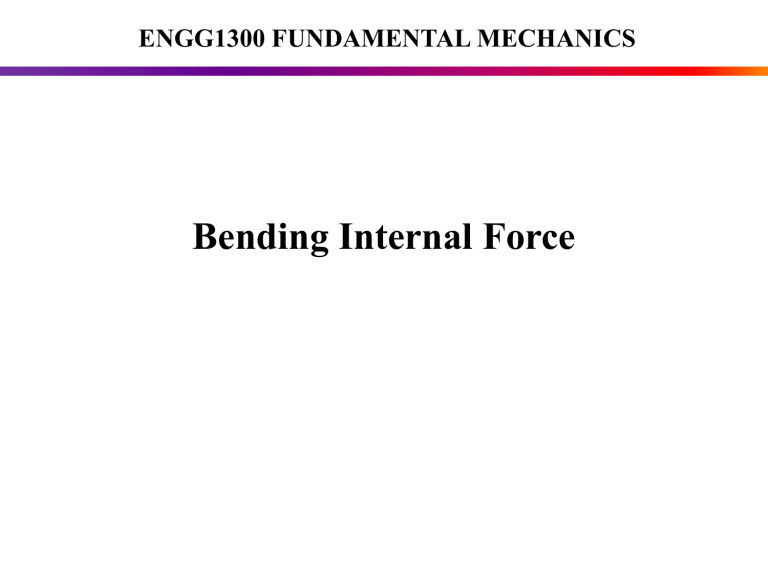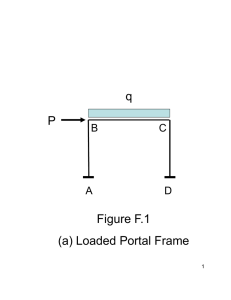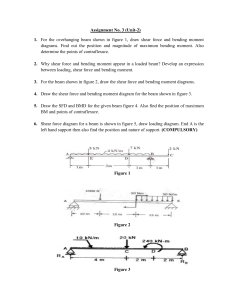
ENGG1300 FUNDAMENTAL MECHANICS Bending Internal Force Introduction 2 Introduction 3 Introduction 4 Internal Forces in Beams • Internal forces on cross-sections of bending beams m F A B m FA m A M FS m m F FB M FS m The internal forces on cross-section m-m can be simplified as shear force and bending moment acting at cross-sectional centroid. B 5 Symmetric Bending • Beam: a structural element which takes bending as the main form of deformation. • Symmetric bending: all external forces & moments acting in the symmetric longitudinal plane (beam axis being bent from a straight line to a curve within the symmetric longitudinal plane). 6 Types of Beams Simply supported beam Beam with an overhang Cantilever beam Compound beam Types of Supports and Reactions Fixed support Hinged or pinned support FRx FRx MR FRy Roller support FRy FRy 8 Determinacy of Beams • Statically determinate beams • Statically indeterminate beams - Cantilever beam - Simply supported cantilever beam - Simply supported beam - Continuous beam - Overhanging beam - Fixed beam 9 Sign Convention of shear Force and Bending Moment • Shear force - Positive: left up / right down (clockwise loop) FS FS FS FS • Bending moment - Positive: upper half under compression / lower half under tension (top concave / bottom convex) Sagging moment M M Hogging moment M M 10 Example 4.1 • Find the shear force and bending moment at the left and right cross-section at point C. F A • Solution: B C FA a a F FA = FB = 2 1. Reaction forces at the supports 2. Internal forces (assuming positive) at the right crosssection of C. F FSCA = FA = 2 Fa M CA = FA a = 2 FB FSCA A MCA FA 11 3. Internal forces (assuming positive) at the left crosssection of C. F A B C a F FSCB = − FB = − 2 Fa M CB = FB a = 2 a FSCB MCB B FB Note: For a concentrated force acting at C, the change of bending moment is zero while that of shear force is equal to the magnitude of the concentrated force. 12 Example 4.2 • Find the shear force and bending moment at the left and right Fa cross-section at point C. A • Solution: B C a FA a FB 1. Reaction forces at the supports F FA = FB = 2 FSCA 2. Internal force at the right cross-section of C. F FSCA = FA = 2 Fa M CA = FA a = 2 A FA MCA 13 3. Internal force at the left cross-section of C. Fa A a FSCB F = FB = 2 M CB Fa = − FB a = − 2 B C a FSCB MCB B FB Note: For a concentrated moment acting at C, the change of shear force is zero while that of bending moment is equal to the magnitude of the concentrated moment. 14 Direct Calculation of Shear Force • The shear force at a beam cross-section is equal to the net of the external forces collected from either side of the cross-section. • Upward net from left portion or downward net from right portion results in positive shear force at the cross-section. • All forces acting on a beam, including the reaction forces at the supports, must be taken into consideration. 15 Example 4.3 • Directly calculate the shear force at cross-section C without the explicit use of method of section. • Solution: F1 F3 F4 q A B C FA F2 FB - Based on the left portion from cross-section C: FSC = FA − F1 + F2 − F3 - Based on the right portion from cross-section C: FSC = − FB + ql + F4 Note: in practice, we pick the portion with simpler loadings. 16 Direct Calculation of Bending Moment • The bending moment at a beam cross-section is equal to the net of the external moments with respect to the cross-section centroid, collected from either side of the cross-section • Clockwise net from left portion or counter clockwise net from right portion results in positive bending moment. • All forces acting on a beam, including the reaction forces at the supports, must be taken into consideration. 17 Example 4.4 • Directly calculate the bending moment at cross-section C without the explicit use of method of section. • Solution: F1 M1 A - Based on the left portion from cross-section C FA C B F2 FB MC = FAd A − F1d1 − M1 - Based on the right portion from cross-section C MC = − FB d B + F2d 2 18 Diagram of Shear Forces & Bending Moments • Equation of shear forces and bending moments - Equation of shear forces: FS = FS(x) - Equation of bending moments: M = M(x) - x: denotes the position of cross-section. • Diagram of shear forces and bending moments - Abscissa: cross-section position (x) - Ordinate: shear forces (FS) / bending moments (M) 19 Example 4.5 • Draw the diagram of shear forces and bending moments F x1 A FA x2 B C a a FB • Solution: F 1. Reaction force at the supports: FA = FB = 2 2. Equation of internal forces F FS ( x1 ) = FA = 2 F FS ( x2 ) = − FB = − 2 x1 [0, a) x2 [0, a) Positive: left & upward Negative: right & upward 20 FS Fx1 x1 [0, a) M ( x1 ) = FA x1 = 2 0.5F 0.5F x1 x2 F C A B Positive: left & clockwise Fx2 M ( x2 ) = FB x2 = 2 x2 [0, a) FA a a FB Positive: right & counter clockwise M 0.5 Fa 21 Example 4.6 • Draw the diagram of shear forces and bending moments x1 A • Solution: FA C a 1. Reaction forces at the supports x2 Fa a B FB FS 0.5F F FA = FB = 2 2. Equations of internal forces F F FS ( x1 ) = ; FS ( x2 ) = 2 2 Fx1 Fx2 M ( x1 ) = ; M ( x2 ) = − 2 2 -0.5Fa M 0.5Fa 22 Example 4.7 q A B ql 2 FS x • Plot the diagram of shear forces and bending moments • Solution: ql 2 l • ql / 2 1. Reaction forces at the supports 2. Equation of internal forces ql FS ( x) = − qx 2 • −ql / 2 ql x M ( x) = x − qx 2 2 2 • M q l2 / 8 3. Diagram of internal forces q l q l2 =− x− + 2 2 8 (0 x l ) 23 Relations among Loads, Shear Forces and Bending Moments q( x) q( x) x M (x ) M ( x ) + dM ( x ) dx FS ( x) FS ( x) + dFS ( x) FS ( x ) + q ( x ) dx − FS ( x ) − dFS ( x ) = 0 1 M ( x ) + dM ( x ) − q ( x ) d 2 x − M ( x ) − FS ( x ) dx = 0 2 24 Relations among Loads, Shear Forces and Bending Moments FS ( x ) + q ( x ) dx − FS ( x ) − dFS ( x ) = 0 x2 dFS ( x ) q ( x) = , FS2 − FS1 = q ( x ) dx dx x1 1 M ( x ) + dM ( x ) − q ( x ) d 2 x − M ( x ) − FS ( x ) dx = 0 2 dM ( x ) FS ( x ) = , dx dM 2 ( x ) q ( x) = dx 2 M 2 − M1 = x2 F ( x ) dx S x1 Sign convention of q(x): up positive / down negative. 25 Relations among Loads, Shear Forces and Bending Moments • Without distributed load: q(x) = 0 dFS ( x ) q ( x) = =0 dx FS ( x ) = const Note: the slope of the diagram of shear forces is zero. dM ( x ) = FS ( x ) = const dx M ( x ) = ( const ) x + ( const ) Note: the slope of the diagram of bending moments is constant. 26 Relations among Loads, Shear Forces and Bending Moments • With uniformly distributed load: q(x) = const dFS ( x ) q ( x) = = const dx FS ( x ) = ( const ) x + ( const ) Note: the slope of the diagram of shear forces is constant. dM ( x ) = FS ( x ) dx M ( x ) = ( const ) x 2 + ( const ) x + ( const ) Note: M(x) is a second order polynomial of x. 27 Relations among Loads, Shear Forces and Bending Moments Loads No load (P=0 & q=0) Uniformly distributed q=const Concentrated load (P) C Diagram of shear forces FS 0 q0 q0 Discontinuous Fs C Concentrated moment (m) C FS 0 Diagram of bending moments FS 0 FS 0 q0 q0 C Continuous but not differentiable M Discontinuous M Const C 28 Example 4.8 • Draw the diagram of shear forces and bending moments. A B • Solution: FA ql FA = 8 5ql FB = 8 FS q l FB 2 l C ql / 2 −ql / 8 − ql 2 / 8 M 29 Example 4.9 q • Draw the diagram of shear forces and bending moments. A • Solution: FA 3ql FA = 8 ql FB = 8 FS 3ql 8 B l 2 l 2 x = •3l 8 •x = l 2 • M 9ql 2 128 FB − ql 8 • ql 2 16 30 Example 4.10 • Draw the diagram of shear forces and bending A moments. q • Solution: a FA = qa FB = qa FA FS qa B a −qa M qa 2 / 2 qa a FB −qa 2 / 2 qa 2 / 2 31 Example 4.11 • Draw the diagram of shear forces and bending moments. q qa 2 / 2 A q a • Solution: qa FA = 2 FB = qa 2 FS qa B FA a FB qa / 2 −qa / 2 M qa 2 / 8 qa 2 / 2 32



